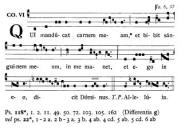Weird divergence … “Qui manducat” communion
-
Compare this chant from the Liber Usualis:
http://www.christusrex.org/www2/cantgreg/partituras/co_qui_manducat.gif
… with the one from the Gregorian Missal and Graduale Romanum:
http://media.musicasacra.com/books/gregorianmissal-eng.pdf
There are notable differences between the two.
I have read people assert before that nothing in the chant notation changed from the 1908 Solesmes edition through the 1974 Graduale. This seems to illustrate that that’s not always true … ?
It also seems to imply that we aren’t ultimately safe “mixing and matching” pre-V2 and post-V2 Solesmes resources … which kind of undercuts a central assumption that a lot of chant proper collections seem to make … ?Thanked by 1CHGiffen -
At least in my graduale romanum ('74), it's the same as the Liber.Thanked by 1lagunaredbob
-
The only difference I see is that the Gregorian Missal has the asterisk at the first half bar instead of after "mandúcat", and the dot on "-cat" was dropped. The 1974 Graduale has the same. Many of the chants in the 1974 Graduale have the incipit lengthened in this fashion. The only proper chant I'm aware of that is truly changed is the Graduale Domine refugium for the 21st Sunday after Pentecost/27th Sunday in Ordinary Time.
-
Felipe writes:It also seems to imply that we aren’t ultimately safe “mixing and matching” pre-V2 and post-V2 Solesmes resources … which kind of undercuts a central assumption that a lot of chant proper collections seem to make … ?
In the Winter 2008 Sacred Music, Jeff Ostrowski presents an article about chant notation in the Vatican Graduale 1908 and states that various editions printed by other publishers differed in their rhythmic markings.
The Graduale from the Holy See represented rhythmic nuance by -- of all things! -- the *spacing* between notes. This seemed an impractical method of notation at the time, and the publishers authorized to print the book were allowed to offer their own improvements on it. They were required to preserve the notes and their spacing, but were free to add their own rhythmic markings.
Since the markings were optional then, and variation was not a problem then, it seems sensible to regard variations between editions as Not A Problem now, including for EF Masses.
Thanked by 1CHGiffen -
If the discrepancies were merely asterisks that would be one thing, but if there are differences in dots (which most folks seem to interpret as rhythmically significant) that will require a longer rehearsal with more talking.
Every little bit counts … -
the asterisk at the first half bar instead of after "mandúcat", and the dot on "-cat" was dropped
Unless the manuscripts had episema (I haven't GT at hand), the dot on "-cat" in LU seems to be the rhythmic consequence of the asterisk. The latter being removed in GR1974, the former, too, had to go.Thanked by 1CHGiffen
Welcome to the MusicaSacra Forum!
To participate in the discussions on Catholic church music, sign in or register as a forum member, The forum is a project of the Church Music Association of America.
Categories
- All Discussions21,107
- General Music Discussion7,594
- Job Openings1,303
- Management of Music Programs833
- Choral Matters519
- Church Documents and Rubrics504
- CMAA Notes291
- Events651
- For Newcomers: Read First23
- Sacred Polyphony528
- Hymnody821
- Gregorian Chant: General2,582
- ↳ Graduale Romanum and Liber Usualis354
- ↳ Graduale Simplex55
- ↳ Semiology57
- Vernacular Plainsong671
- Anglican Use and Anglican Chant66
- Organ, Other Instruments and Repertoire414
- New Composition/Works in Progress1,208
- Recordings222
- Music for Hispanic Ministry151
- Music Education: Children205
- Music Education: General214
- News Items242
- Positions Wanted58
- General Discussion: Catholicism723
- Amusements170
- General Discussion1,001
- Opinions113







